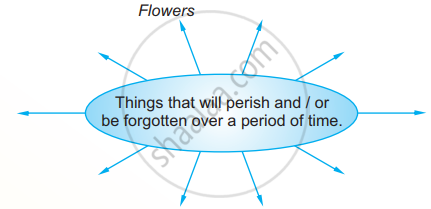Advertisements
Chapters

Advertisements
Solutions for Chapter 8: Not Marble, nor the Gilded Monuments
Below listed, you can find solutions for Chapter 8 of CBSE CBSE for English Communicative - Literature Reader Class 10.
CBSE solutions for English Communicative - Literature Reader Class 10 8 Not Marble, nor the Gilded Monuments Exercises [Pages 97 - 100]
Look at the following picture carefully.

a) What has Time been portrayed as? Why?
b) What are the other symbols associated with Time?
What are the things that last for centuries? List a few things around you that will survive four to five hundred years into the future.

Think of things that will perish and/or be forgotten with the passage of time.

On the basis of your understanding of Shakespeare's sonnet, answer the following question by ticking the correct option.
- The rich and powerful got ornate monuments made in order to _______________
show off their wealth
display their power
show their artistic talent
be remembered till posterity
On the basis of your understanding of Shakespeare's sonnet, answer the following question by ticking the correct option.
- The poet addresses his sonnet to ____________________________________
time
war
the person he loves
powerful rulers
On the basis of your understanding of Shakespeare's sonnet, answer the following question by ticking the correct option.
- In the line 'The living record of your memory', living record refers to ____________
the sonnet the poet has written for his friend
an existing statue of his friend
his friend who lives in the poet's memory
the autobiography of the poet's friend
On the basis of your understanding of Shakespeare's sonnet, answer the following question by ticking the correct option.
The poet's tone in the poem is _______________________________________
despairing
optimistic
loving
admiring
On the basis of your understanding of Shakespeare's sonnet, answer the following question by ticking the correct option.
The poem is set in _____________________
the place where the poet meets his friend
a battlefield where Mars is fighting a battle
a city ravaged by war
the poet's study where he is writing
Answer the following question briefly.
Why do you think the rich and powerful people get monuments and statues erected in their memory ?
Answer the following question briefly.
Describe how the monuments and statues brave the ravages of time.
Answer the following question briefly.
Why does the poet refer to Time as being sluttish ?
Answer the following question briefly.
The poet says that neither forces of nature nor wars can destroy his poetry. In fact, even godly powers of Mars is not going to have a devastating effect on his rhyme. What quality of the poet is revealed through these lines?
Shakespeare's sonnet has been divided into three quatrains of four lines, each followed by a rhyming couplet. Each quatrain is a unit of meaning. Read the poem carefully and complete the following table on the structure of the poem.
| Rhyme scheme | Theme | |
| Quatrain 1 | Comparison between poetry and monuments. | |
| Quatrain 2 | Ravages of time on monuments contrasted with _______________ |
|
| Quatrain 3 | The recorded memory of ____________________posterity | |
| Couplet | Poetry immortalises friend |
The poet uses alliteration to heighten the musical quality of the sonnet. Working in pairs, underline the examples of alliteration in the poem.
Identify Shakespeare's use of personification in the poem.
Solutions for 8: Not Marble, nor the Gilded Monuments

CBSE solutions for English Communicative - Literature Reader Class 10 chapter 8 - Not Marble, nor the Gilded Monuments
Shaalaa.com has the CBSE Mathematics English Communicative - Literature Reader Class 10 CBSE solutions in a manner that help students grasp basic concepts better and faster. The detailed, step-by-step solutions will help you understand the concepts better and clarify any confusion. CBSE solutions for Mathematics English Communicative - Literature Reader Class 10 CBSE 8 (Not Marble, nor the Gilded Monuments) include all questions with answers and detailed explanations. This will clear students' doubts about questions and improve their application skills while preparing for board exams.
Further, we at Shaalaa.com provide such solutions so students can prepare for written exams. CBSE textbook solutions can be a core help for self-study and provide excellent self-help guidance for students.
Concepts covered in English Communicative - Literature Reader Class 10 chapter 8 Not Marble, nor the Gilded Monuments are Not Marble, Nor the Gilded Monuments, Grammar, Idioms and Phrases, Figures of Speech, Rhyme Scheme, Verb, Punctuation, Spotting Errors, Make a Sentence, Helping Verbs, Direct-Indirect Speech, Missing Words, Unseen Passage Comprehension, Unseen Poem Comprehension, Reading Skills, Listening Skills, Writing Skills, Information Transfer, Letter Writing, E-mails Writing, Article Writing, Dialogue Writing, Tourist Leaflet, Report Writing, Film Review, Notice Writing, Story Writing, Paragraph Writing, Dialogue Writing, Diary Entry, Speech Writing, Listening Skills, Writing Skills, Information Transfer, Letter Writing, E-mails Writing, Article Writing, Dialogue Writing, Tourist Leaflet, Report Writing, Film Review, Notice Writing, Story Writing, Paragraph Writing, Dialogue Writing, Diary Entry, Speech Writing.
Using CBSE English Communicative - Literature Reader Class 10 solutions Not Marble, nor the Gilded Monuments exercise by students is an easy way to prepare for the exams, as they involve solutions arranged chapter-wise and also page-wise. The questions involved in CBSE Solutions are essential questions that can be asked in the final exam. Maximum CBSE English Communicative - Literature Reader Class 10 students prefer CBSE Textbook Solutions to score more in exams.
Get the free view of Chapter 8, Not Marble, nor the Gilded Monuments English Communicative - Literature Reader Class 10 additional questions for Mathematics English Communicative - Literature Reader Class 10 CBSE, and you can use Shaalaa.com to keep it handy for your exam preparation.
